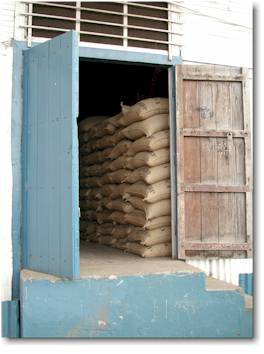|
 How to Store Coffee: Green and Roasted How to Store Coffee: Green and Roasted
Green Coffee. Green coffee must be stored in dry
and cool conditions. Exposure to the sun or moisture will
rapidly deteriorate the coffee. Storage in pergamino until
shipment will help preserve the coffee.
Seedling Storage. Research
in Kenya has shown that seeds are useful for over two years
if stored at 15°C at 41% moisture content in a airtight
polythene bag (Mitchell, 45
and Van der Vossen).
Roasted Coffee. Whole bean coffee
maintains its freshness the longest. The freshness of ground
coffee will be lost in a matter of minutes since its protective
cellular structure has been broken and the volatiles have
been exposed to the environment to undergo oxidation. An
inert gas such as nitrogen can be used to help preserve
the whole beans for an extended time. Some people claim
that nitrogen could preserve coffee for up to two years,
but after a few weeks the coffee no longer acts, tastes,
nor smells like freshly roasted coffee. Whole bean coffee
that has been opened and exposed to the environment should
be kept for no longer than a week even if a vacuum seal
is in place. Coffee that has been roasted very darkly is even more susceptible
to oxidation and should be kept for an even shorter period
of time. Finally, there is a significant loss in crema development
for espresso coffee four days after roasting. Espresso coffee should be purchased
immediately after roasting and consumed within a couple
of days.
Related
Articles
Harvesting
Coffee
Processing
Coffee
Coffee
Drying
Color
Sorting Coffee
Density
Sorting Coffee
Flavor
Characteristics Due to Processing
|


